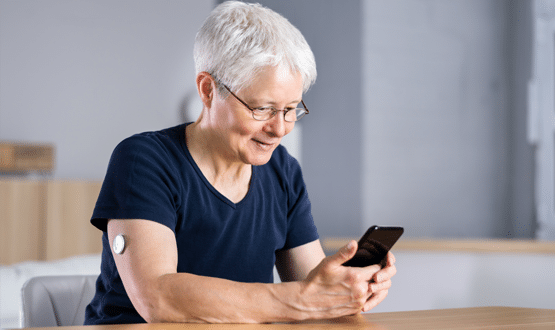Will an uptake in digital health services have implications on inequalities?
- 10 August 2021

The use of digital health services has risen over the course of the Covid-19 pandemic – but will this have implications on inequalities? Emma Stone, director of design, research and communications at the Good Things Foundation, explores.
Our reliance on digital technology during the pandemic has facilitated innovation and improved digital access for many – in healthcare and beyond. For others, the goalposts have been moved, putting them at a new disadvantage that threatens their health. We need to build on the momentum and apply the learnings of the pandemic to reach those who have fallen further behind.
An unequal divide
The digital divide and the resulting impact on people’s experiences of the pandemic have disproportionately affected certain groups of society. Unsurprisingly, older people are least likely to use digital services – due to a lack of confidence or inaccessibility. Age UK analysis suggested that only 24% of those aged 75+ were using the internet more during the pandemic, and 9% were using it less.
According to Ofcom, the population has become better connected since the start of the pandemic, but 6% of homes (around 1.5 million households) in the UK lack home internet access. People in the poorest households are four times more likely to not use the internet at home than those in the wealthiest households. They have also been most impacted during lockdown by the loss of previously available ‘workarounds’ – such as accessing free wi-fi and computers in community centres and libraries.
Disability, impairment, and health conditions also correlate with lower levels of digital access and use. Analysis of Ofcom data suggests up to 5.7 million disabled people in England face digital exclusion. In addition, some individuals from minority ethnic communities may face added barriers, such as a lack of trust in technology or public services, language barriers or limited knowledge of how best to access public services.
Being able to afford and use the internet is no longer a ‘nice to have’ – certainly for children and adults of working-age, and increasingly for those in later life too. In a society where services are shifting online, the case is growing for internet access to be seen as a right.
Digital exclusion and health
Digital access and skills need to be recognised as wider determinants of health. They are now essential for education, employment and social participation as well as for accessing public services, including health services.
The nation was quick to respond to COVID-19 to protect the NHS, with many services moving online. We have witnessed increased adoption of digital health tools, including remote monitoring, virtual consultations, and online patient information. Many have adjusted and benefited from improved control and convenience. According to the Lloyds Consumer Digital Index 2021, around 49% of people say the internet helps them manage and improve their physical and mental health.
However, the pace of change and the imperatives of managing the pandemic have meant many of these changes happened without sufficient patient and public participation, as reports from National Voices and Healthwatch England have highlighted. As the NHS and health providers embrace this new online world, people who are low or limited users of digital technology are at risk of poorer health outcomes.
Furthermore, as the health system increasingly adopts digital technologies such as wearable trackers and the ‘test and trace’ app, data available for crucial decision-making may become skewed towards groups with improved digital access – creating the potential for algorithmic bias with impacts on allocation of health resources.
Only an inclusive approach to digital transformation can help achieve better health outcomes for all, and realise the potential for digital and assistive technologies to reduce health inequalities in poorly served communities.
Getting there will require ensuring everyone has the digital access, skills and confidence they need (for example, through the expansion and capacity building of community digital health hubs). This includes not only patients but also the wider health and care workforce. To achieve this, Government will have to work collaboratively across sectors to deliver joined-up strategies at local, regional and national levels.
Current data on digital health inequalities – and what works in addressing them – is worryingly inadequate, and all sectors must collect better data to track the dynamic relationship between digital access and health outcomes and inform decision-making. Patient engagement and feedback must also be a focus to design inclusive digital and non-digital health services during the COVID-19 recovery. Only by examining these issues from the standpoint of equity and digital inclusion, can we then ensure our universal right to health care.
Beyond COVID-19: unpacking the divide
Positive steps have been made by industry, government, and the NHS to tackle digital exclusion. Yet, there are still critical gaps that must be addressed to lessen the impact on health and wider inequalities. It is unclear whose responsibility it is to ensure that everyone has the access, skills, and confidence they need to benefit from digital for their health.
Rapid innovation and new collaboration – in the NHS and communities – have been hallmarks of our emergency response. Is there a risk that we will lose momentum, instead of rising to the challenge of evolving sustainable and inclusive strategies for healthier lives in a digital world?
The Health Foundation’s Covid-19 impact inquiry has made good headway, drawing on what we know so far to inform the UK’s recovery and ensure everyone can enjoy good health. However, the inquiry has exposed crucial knowledge gaps in our understanding of how digital technologies shape health access, equity, and outcomes for different groups.
If we can turn this around – striving for a 100% digitally included nation – we can harness technology to promote healthy lives, improve access to health care, and reduce inequalities. Surely this is our goal as we emerge from one of the most difficult events in recent history.





1 Comments
This article is so full of false assumptions that it is hard to know where to begin. I can think of nothing, at this point in time, that is a greater threat to my health and well being than digital technology. This is not a matter of lack of access or inability to use the technology. The problem is that there is nowhere to hide from the insanity it begets. I am forced to spend my time finding out where the next threat is coming from and this is not how I wish to live my life. The root cause of the problem is a government policy of using healthcare to grow the digital technology sector. We do not need a healthcare system driven by the commercial ambitions of the digital technology sector. I am not “left behind” – I am running in the opposite direction as hard as I can, but nobody can escape this all engulfing tsunami that destroys everything in its path.
Comments are closed.